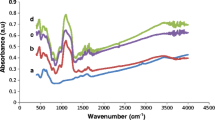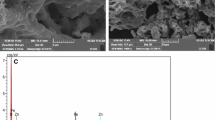Abstract
Designing an immobilised metal ion affinity process on large-scale demands that a thorough understanding be developed regarding the adsorption behaviour of proteins on metal-loaded gels and the characteristic adsorption parameters to be evaluated. In view of this requirement, interaction of α-amylase as a model protein with newly synthesised magnetic-poly(divinylbenzene-1-vinylimidazole) [m-poly(DVB-VIM)] microbeads (average diameter, 53–212 μm) was investigated. The m-poly(DVB-VIM) microbeads were prepared by copolymerising of divinylbenzene (DVB) with 1-vinylimidazole (VIM). The m-poly(DVB-VIM) microbeads were characterised by N2 adsorption/desorption isotherms, electron spin resonance, elemental analysis, scanning electron microscope and swelling studies. Cu2+ ions were chelated on the m-poly(DVB–VIM) beads and used in adsorption of α-amylase in a batch system. The maximum α-amylase adsorption capacity of the m-poly(DVB–VIM)–Cu2+ beads was determined as 10.84 mg/g at pH 6.0, 25 °C. The adsorption data were analyzed using three isotherm models, which are the Langmuir, Freundlich and Dubinin–Radushkevich isotherm models. The pseudo-first-order, pseudo-second-order, modified Ritchie’s-second-order and intraparticle diffusion models were used to test dynamic experimental data. The study of temperature effect was quantified by calculating various thermodynamic parameters such as Gibbs free energy, enthalpy and entropy changes.





Similar content being viewed by others
References
Porath, J., & Olin, B. (1983). Immobilised metal ion affinity adsorption and immobilised metal ion affinity chromatography of biomaterials. Serum protein affinities for gel-immobilised iron and nickel ions. Biochemistry, 22, 1621.
Gupta, R., Mohapatra, H., Goswami, V., & Chauhan, B. (2003). Microbial α-amylases: a biotechnological perspective. Proceeding Biochemical, 38, 1.
Bayramoğlu, G., Yılmaz, M., & Arıca, M. Y. (2004). Immobilisation of a thermostable a-amylase onto reactive membranes: kinetics characterization and application to continuous starch hydrolysis. Food Chemistry, 84, 591.
Guiavarch, Y., Loey, A. V., Zuber, F., & Hendrickx, M. (2004). Bacillus licheniformis alpha-amylase immobilised on glass beads and equilibrated at low moisture content: potentials as a time temperature integrator (TTI) for sterilization processes. Innovation Food Science Emergency, 5, 317.
Kara, A., Osman, B., Yavuz, H., Besirli, N., & Denizli, A. (2005). Immobilisation of a- amylase on Cu2+-chelated Poly (ethylene glycol dimethacrylate -n-vinyl imidazole) matrix via adsorption. Reactive and Functional Polymers, 62, 61.
Bryjak, J. (2003). Glucoamylase, a-amylase and [beta]-amylase immobilisation on acrylic carriers. Biochemical Engineering Journal, 16, 347.
El-Batal, A. I., Atia, K. S., & Eid, M. (2005). Stabilization of a-amylase by using anionic surfactant during the immobilisation process. Radiation Physics and Chemistry, 74, 96.
Konsoula, Z., & Liakopoulou-Kyriakides, M. (2006). Starch hydrolysis by the action of an entrapped in alginate capsules alpha-amylase from Bacillus subtilis. Process Biochemistry, 41, 343.
Namdeo, M., & Bajpai, S. K. (2009). Immobilisation of α-amylase onto cellulose-coated magnetite (CCM) nanoparticles and preliminary starch degradation study. Journal Molecular Catalysis B, 59, 134.
Liao, Y. C., & Syu, M. J. (2005). Novel immobilised metal ion affinity adsorbent based on cross-linked b-cyclodextrin matrix for repeated adsorption of α-amylase. Biochemical Engineering Journal, 23, 17.
Osman, B., Kara, A., Uzun, L., Beşirli, N., & Denizli, A. (2005). Vinyl imidazole carrying metal-chelated beads for reversible use in yeast invertase adsorption. Journal of Molecular Catalysis B: Enzymatic, 37, 88.
Kök, S., Osman, B., Kara, A., & Besirli, N. (2011). Vinyl Triazole Carrying Metal Chelated Beads For Reversible Immobilization of Glucoamylase. Journal of Applied Polymer Science, 120, 2563.
Sharma, S., & Agarwal, G. P. (2001). Interactions of Proteins with Immobilised Metal Ions: a Comparative Analysis Using Various Isotherm Models. Analytical Biochemistry, 288, 126.
Sharma, S., & Agarwal, G. P. (2002). Adsorption equilibrium and kinetics of egg-white proteins on immobilized metal ion affinity gels for designing fractionation. Adsorption, 8, 203.
Nguyen, Q. D., Rezessy-Szabo, J. M., Claeyssens, M., Stals, I., & Hoschke, A. (2002). Purification and characterisation of amylolytic enzymes from thermophilic fungus Thermomyces lanuginosus strain ATCC 34626. Enzyme and Microbial Technology, 31, 345.
Sohmiya, M., Ogawa, M. (2012). Controlled spatial distribution of tris(2,2′-bipyridine)ruthenium cation ([Ru(bpy)3]2+) in aluminum containing mesoporous silicas. Microporous and Mesoporous Materials 142, 363.
Wu, X. W., Ma, H. W., Li, J. H., Zhang, J., & Li, Z. H. J. (2007). The synthesis of mesoporous aluminosilicate using microcline for adsorption of mercury(II). Colloid Interface Science, 315, 555.
Li, J., Miao, X. M., Hao, Y., Zhao, J., Sun, X., & Wang, L. (2008). Synthesis, amino-functionalization of mesoporous silica and its adsorption of Cr(VI). Journal of Colloid and Interface Science, 318, 309.
Şenel, S., Uzun, L., Kara, A., & Denizli, A. (2008). Heavy metal removal synthetic solutions with magnetic beads under magnetic field. Journal Macromolecular Science Pure and Applied Chemistry A, 45, 635.
Sivaramakrishnan, S., Gangadharan, D., Nampoothiri, K. M., & Pandey, A. (2006). Solid culturing of Bacillus amyloliquefaciens for alpha amylase production. Food Technology and Biotechnology, 44, 269.
Lagergren, S. (1898). Zur theorie der sogenannten adsorption gelöster stoffe. Kungliga Svenska Vetenskapsakademiens. Handlingar, 25, 1.
Ho, Y. S., & McKay, G. (1999). Pseudo-second order model for sorption processes. Process Biochemistry, 34, 451.
Daoud, F. B., Kaddour, S., & Sadoun, T. (2010). Adsorption of cellulase Aspergillus niger on a commercial activated carbon: Kinetics and equilibrium studies. Colloids and Surfaces. B, Biointerfaces, 75, 93.
Plazinski, W., Rudzinski, W., & Plazinska, A. (2009). Theoretical models of sorption kinetics including a surface reaction mechanism: a review. Advances in Colloid and Interface Science, 152, 2.
Zhao, Z., Wang, X., Zhao, C., Zhu, X., & Du, S. (2010). Adsorption and desorption of antimony acetate on sodium montmorillonite. Journal of Colloid and Interface Science, 345, 154.
Hoa, Y. S., & Ofomaja, A. E. (2006). Kinetic studies of copper ion adsorption on palm kernel fibre. Journal Hazards Materials B, 137, 1796.
Ertugay, N., & Bayhan, Y. K. (2010). The removal of copper (II) ion by using mushroom biomass (Agaricus bisporus) and kinetic modelling. Desalination, 255, 137.
Sağ, Y., & Kutsal, T. (2000). Determination of the biosorption activation energies of heavy metal ions on Zoogloea ramigera and Rhizopus arrhizus. Process Biochemistry, 35, 801.
Kara, A., Acemioğlu, B., Alma, M. H., & Cebe, M. (2006). Adsorption of Cr(II), Ni(II), Zn(II), Co(II) ions onto phenolated wood resin. Journal of Applied Polymer Science, 101, 2838.
Tekin, N., Kadıncı, E., Demirbaş, Ö., Alkan, M., & Kara, A. (2006). Adsorption of polyvinylimidazole onto kaolinite. Journal of Colloid and Interface Science, 296, 472.
Doğan, M., Alkan, M., & Onganer, Y. (2000). Adsorption of methylene blue on perlite from aqueous solutions. Water, Air, and Soil Pollution, 120, 229.
Namasivayam, C., & Kavita, D. (2002). Removal of congo red from water by adsorption on to activated carbon prepared from coir pith, an agricultural solid waste. Dyes and Pigment, 54, 47.
Laus, R., Costa, T. G., Szpoganicz, B., & Fávere, V. T. (2010). Adsorption and desorption of Cu(II), Cd(II) and Pb(II) ions using chitosan crosslinked with epichlorohydrin-triphosphate as the adsorbent. Journal of Hazardous Materials, 183, 233.
Chen, A. H., Liu, S. C., & Chen, C. Y. (2008). Comparative adsorption of Cu(II), Zn(II) and Pb(II) ions in aqueous solution on the crosslinked chitosan with epichlorohydrin. Journal of Hazardous Materials, 154, 184.
Tripathy, S. S., & Raichur, A. M. (2008). Abatement of fluoride from water using manganese dioxide-coated activated alumina. Journal of Hazardous Materials, 153, 1043.
Özcan, A., Özcan, A. S., Tunali, S., Akar, T., & Kiran, I. (2005). Determination of the equilibrium, kinetic and thermodynamic parameters of adsorption of copper(II) ions onto seeds of capsicum annuum. Journal of Hazardous Materials, 124, 200.
Ünlü, N., & Ersoz, M. (2006). Adsorption characteristics of heavy metal ions onto a low cost biopolymeric sorbent from aqueous solutions. Journal Hazards Materials B, 136, 272.
Tassist, A., Lounici, H., Abdi, N., & Mameri, N. (2010). Equilibrium, kinetic and thermodynamic studies on aluminum biosorption by a mycelial biomass (Streptomyces rimosus). Journal of Hazardous Materials, 183, 35.
Zhou, Y. T., White, C. B., Nie, H. L., & Zhu, L. M. (2009). Adsorption mechanism of Cu2+ from aqueous solution by chitosan-coated magnetic nanoparticles modified with α-ketoglutaric acid. Colloids and Surfaces B Biointerfaces, 74, 244.
Author information
Authors and Affiliations
Corresponding author
Rights and permissions
About this article
Cite this article
Osman, B., Kara, A., Demirbel, E. et al. Adsorption Equilibrium, Kinetics and Thermodynamics of α-Amylase on Poly(DVB-VIM)-Cu+2 Magnetic Metal-Chelate Affinity Sorbent. Appl Biochem Biotechnol 168, 279–294 (2012). https://doi.org/10.1007/s12010-012-9771-z
Received:
Accepted:
Published:
Issue Date:
DOI: https://doi.org/10.1007/s12010-012-9771-z




